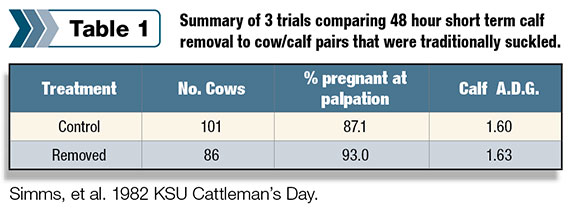Removal of the suckling stimulus for two days has the effect of “fooling Mother Nature” as some of the cows will begin to produce and release the hormones that cause the cow to return to heat cycles.
The care of the calf during that 48 hours is actually quite simple.
Most producers will make certain that calves access to some "sweet" feed, high-quality hay and plenty of fresh drinking water. The calves will eat very little during this time.

Removal of calves for 48 hours has been shown to improve rebreeding rates of moderately conditioned (body condition score = 5) cows by 4 to 8 percent. (See Table 1.)
This improvement although, seemingly small in magnitude is large compared to the out-of-pocket investment.
Short-term calf removal can be used at the first of the breeding season or in the middle or both depending on the labor situation. Short-term calf removal is not a powerful enough stimulus to "jump start" very thin cows.
Those that are in a body condition score of 4 or less may need to have the calves weaned completely to allow the cow to recycle early in the upcoming breeding season.
Those cows that calve in the body condition score 6 or fatter can be expected to return to estrus early in the breeding season and should have high rebreeding rates. Although not harmful, the practices of early weaning, short-term calf removal, or feeding extra feed will not show significant advantages for these cows.
Therefore producers will want to continue their normal lactating cow supplementation programs until warm-season grass provides the nutrients that these cows need.
Concerns about calf health and growth are overcome by comparing the average daily gain over the entire seven months of calf nursing. Those that were removed from the cows for 48 hours grew as rapidly and had similar weaning weights as those who were never removed from their mothers.
Short term-calf removal will test the quality of the fences that separate the calves from the cows. Keep a watchful eye on the cattle during this time frame so that any breakdown in fencing can be noticed soon and cattle and can be returned to the proper pasture or lot as soon as possible.
This is not the time to take a two-day vacation to Las Vegas! ![]()
—From Cow Calf Corner Newsletter, April 22, 2013
Glenn Selk
Emeritus Extension Animal Scientist
Oklahoma State University
PHOTO
Removal of calves for 48 hours has been shown to improve rebreeding rates of moderately conditioned (body condition score = 5) cows by 4 to 8 percent. Staff photo.







